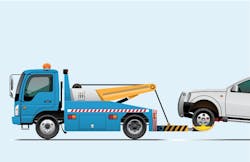SHOP STATS: Bob's Main Street Auto & Towing Location: 2 locations in West Bend, Wis. Owner: Bill and Laurie Rate Average Monthly Car Count: ~500 (combined) Staff Size: 54 (35 dedicated towing staff) Number of lifts: 12 (combined) Shop Size: 12,000 square feet (combined) Annual Revenue: $3.6 million (combined)
Take Bill Rate’s word for it: “A tow truck is not a toy, and it’s not a side gig, and it’s not a hobby.”
He sees it time and time again—shop owners who invest in their own truck, only to leave it parked at the shop as they continue to get swept up in day to day shop operations and decline tow calls.
“Those are actually calls we end up taking,” says Rate, co-owner of two Bob’s Main Street Auto & Towing locations in West Bend, Wis. He finds many shop owners will add towing programs to their services thinking the move will be a convenient add-on to boost shop profits, but won’t ultimately commit the manpower or strategy to see it through.
“Towing is a scenario where putting more eggs in your basket isn’t a safe bet,” he says. “If you’re going to let your trucks sit, it’s just not worth it, but figuring out how to keep those trucks busy without overwhelming your team is a real Rubik’s cube.”
After more than 20 years in the towing business, Rate has learned what it takes to not only make a towing program work, but turn a profit. How? Strategic staffing and tracking.
The Backstory
When Rate and his wife Laurie bought their shop in 1980, the business already had a towing program and several functioning, albeit depleted, tow trucks.
With more than 35 repair shops in the area, their customer service helped set them apart from competition and they knew the ability to tow would give them another chance to win customers over.
The Rates traded in their dilapidated models for one reliable truck and slowly grew their fleet—no small investment, considering the trucks can run anywhere from $100,000-130,000—as well as relationships with independent shops and dealerships, and contracts with local police and club car programs like Geico and AAA.
The Problem
While there’s no shortage of challenges facing towing programs today—heavy industry regulation, insurance and liability responsibilities, gas mileage, costly equipment and maintenance investments, a shortage of skilled drivers, and a large drop in miles driven are all daily concerns—Rate’s biggest problem was organizing workflow.
Strong client relationships and stable accounts brought in steady business, but the flux and unpredictable nature of the service made it difficult to staff accordingly and avoid passing up profitable calls.
“You can try to make predictions based on the weather, but you don’t know when you’re going to get a call so you’re completely at the mercy of the phone ringing without as many options to shuffle and schedule workflow like you can on the repair side,” says Rate.
The Solution
Rate invested in new tools and hired dedicated staff to create a more strategic workflow.
“In order to keep your trucks busy at all times, you have to know where they are, their ETA, and have a queue ready to go, with a dedicated scout to keep things on track and a crew of drivers at the ready,” says Rate. “It’s all about running an organized shift.”
As the shop has built up its fleet of trucks, Rate’s worked diligently to build a deep bench of drivers. He interviews year-round, hands out cards to those he meets with impressive customer service skills, and keeps a constant file of potential new hires at the ready.
He’s also dedicated a member of the team to serve as a dispatcher for all of the shop’s towing calls, and most recently, Rate brought on a designated manager for the towing program to oversee the day to day operations, manage and repair the trucks, and help troubleshoot problems on the go.
Rate has also hired part-time drivers to have at the ready, and restructured the towing staff’s scheduling to allow for staggered starts and give each full time driver one weekday off each week. Homebase, an employee scheduling mobile app, is used now to keep hours and shifts straight.
The team has also streamlined its dispatch and call logging method and cut down their time spent on the phone with a pivot to Beacon Towing software. With the program, the team can receive, accept, manage, and track a tow request digitally through its entire cycle and record the net profit of each call. All of the shop’s trucks are equipped with the software to provide the dispatcher with live updates on their location and status of a tow.
The Aftermath
Today Rate’s trucks are rarely at the shop. “We’ll talk about taking a truck out of rotation and all of a sudden it’s gone. They’re in nearly nonstop motion. I don’t have a spare truck yet,” he says.
Rate now has 16 full time drivers to operate the shop’s 18 tow trucks and a total of 10 part-time staff ready to jump in and fill gaps when needed.
Real-time tracking through the shop’s software has helped Rate determine if incoming requests can be accepted or will be worth the trip, based on where his trucks are currently located out in the field.
With those tracking tools, the team has honed its workflow for maximum profit. Each morning the drivers depart from the shop and split up to cover a 20 to 25-mile radius in each direction while the dispatcher accepts and assigns calls to each driver. Rate’s drivers receive assignment alerts and can send notifications to the shop’s team to note when they are enroute, when they’ve arrived at a call and when they have completed a call.
The software has also helped them track the potential profitability of their partnerships with data on the shop’s net gain from each tow, helping Rate and his team set priorities for calls as they come in—a strategy that’s helped boost the shop’s towing profits to nearly $1.2 million (roughly one third of the shop’s total net profit).
The Takeaway
Rate advises approaching every tow truck like you would a bay—owners should be constantly strategizing how to keep them full and in motion.
“Overall you have to be willing to invest the time, money and staff to build a solid program the way you would any other part of the business, because running out on the occasional call is going to bleed you dry fast,” says Rate.
“There are plenty of X factors, but you have to be ready to commit to those key investments if you want to see a profit.”
About the Author

Megan Gosch
Megan Gosch is the associate editor of Ratchet+Wrench, where she produces content and oversees production of the publication.
